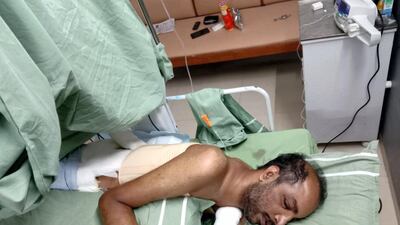The last survivor hurt in the Dubai to Kerala plane crash has finally left hospital almost three months after the disaster.
Noufal Kizekkethil, an Ajman resident, needed a dozen operations including skin transplants to cover gaping wounds exposing his spine.
Doctors were shocked at the man's condition and said they never operated on a single patient with so many complications.
Mr Kizekkethil had such severe injuries to his spine that he risked paralysis.
The UAE resident was among about 170 passengers who survived when Air India Express Flight IX 1344 overshot the Kozhikode runway on August 7.
Twenty-one people died including the pilot and co-pilot.
"I don't remember much about the crash, it was dark [and] I was in too much pain," the 36-year-old told The National.
"I could not see anything but heard voices around," he said.
“Even now I cannot sleep properly because when I close my eyes, I have bad dreams. I have not seen and don’t want to see photos or video of the crash.”
Mr Kizekkethil worked in a gold showroom in the UAE and was returning home to Kerala to start his own business.
When he was brought to hospital, doctors raced to repair his damaged vertebrae, skull and prevent infections from taking hold in critical operations, some that extended more than 12 hours.
For two months after the crash, he was propped up on one side or lay on his stomach to protect his spine. Steel rods were fastened across the outside of his ankles to prevent them dislocating.
“I have seen spine injuries like this in one patient, leg injuries on another but not one patient who has all this thrown in together,” said Dr KS Krishna Kumar, a plastic, reconstructive and vascular surgeon of the Aster group in Kerala, who operated on the man.
“He had multiple fractures of the vertebrae and there was ... loss of tissue, skin and muscle over the vertebrae which means the bones were exposed.
“The fracture on the spine was extensive – it was a huge wound. With the spinal cord exposed he could have [contractec] meningitis – an infection of the brain – and would have ended up a paraplegic so the potential complications were quite catastrophic.”
Teams of critical care doctors and nurses, along with neurosurgery, spine and orthopaedic specialists in Aster MIMS hospital in Kannur, Kerala, worked to save Mr Kizekkethil.
Dr Kumar took portions of tissue from the patient’s upper back and thighs to cover the damaged spine and legs and reconnect small blood vessels to restore circulation.
“The wounds were open and the spine was very unstable so we had to quickly perform procedures to cover the bones,” he said.
“In areas like the tummy, you can pull neighbouring tissue and stitch it up because there is extra skin.
"But there is no loose tissue in the back or around the ankle so we had to take a chunk of tissue along with the artery and vein from other areas and then connect it in the exposed sections."
The flight skidded off the runway when it landed at Kozhikode in Kerala on August 7. An investigation is still ongoing into the cause of the disaster. But experts warned against allowing flights to land on the tabletop runway during wet weather conditions.
Doctors said survivors needed continuous support to recover from the mental and physical scars of the horrific crash.
Aster MIMS hospital in Kannur has treated 44 patients from the crash – the largest number for any hospital.
Mr Kizekkethil requires intensive physiotherapy. Currently in a wheelchair, he will return to hospital for a final operation to fix his right ankle before he can walk again. He counts his blessings to be reunited with his wife and four-year-old son in Kerala.
“I have to manage this for some more months and become strong for my family,” he said.















